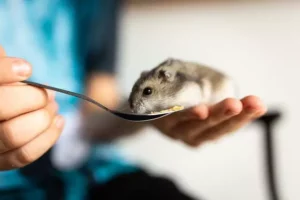0

How to spot a hamster disease will be the topic of today’s somewhat more somber post. It can occasionally be challenging to determine whether your little mammals are ill. Every time you feed your pet, you should check on them to make sure everything seems to be in order.
So, I’ve put together a list of all the most prevalent diseases that could affect your little hamster pal. And what to look for to tell if they have them to help you with your examinations!

These could be symptoms of respiratory infections.
As they result in conditions like pneumonia. Respiratory infections are dangerous.
In the event that your hamster exhibits any of these symptoms, you should call your vet right away. These are brought on by abrupt temperature fluctuations. If you think that the temperature did not cause the respiratory infection. Your hamster’s bedding may be to blame.
Bedding made of cedar and pine has been linked to respiratory issues. Since it usually irritates hamsters’ respiratory systems (which can lead to an infection.) Provide your hamster with paper bedding.
With all of this in mind, the likelihood of your hamster developing a respiratory infection is minimal if they are sneezing. Sneezing can be caused by a variety of things, including dust, and may only indicate that your hamster needs new bedding.
Signs of a Wet Tail: Lethargy, a dirty coat, a damp tail, and loss of appetite are all symptoms of diarrhea.
Hamsters with this ailment run the risk of passing away. But with prompt veterinary care, your hamster should recover quickly.
Abscesses are small pockets of infection that develop as a result of skin breaks, abrasions, or scrapes on your hamster. Pus will collect in these apertures if they are not cleansed or treated, producing lumps that may occasionally drain on their own.
Additionally, abscesses may develop in your hamster’s mouth. Particularly if it consumes tougher foods.
Abscesses can’t heal “over the counter.” so you’ll need a veterinarian to either give you medicines, rinse the abscesses out, or drain them if they’ve gotten too big.
As hamsters’ teeth never stop growing, huge teeth can potentially result in abscesses. I would suggest buying a variety of chew toys for hamsters.
Every animal can get diarrhea, with mushy or moist stools.
Intestinal parasites or dietary changes are the most typical causes of diarrhea. Overfeeding on fresh meals like fruits and vegetables is another potential factor. For a few days, refrain from giving your hamster fresh foods if it has too many fruits or veggies.
You should not notice a drop in activity or a loss of hunger in your hamster. Make careful to take your hamster to the veterinarian if you do detect lethargy or a lack of interest in food.
A sick hamster will frequently stop drinking and start to experience dehydration, which can be exceedingly fatal. Your vet may frequently recommend antibiotics. Or drugs if a parasite or hidden sickness is the cause of diarrhea.
Although hamsters occasionally lose their hair, they are also prone to some skin conditions. Including ringworm. A veterinarian must treat other illnesses such as allergic dermatitis and skin infections.
Change from cedar to paper bedding to aid in the healing process because diseases become worse.
Hamsters are susceptible to ear infections, much like people. Even though they are typically not lethal, ear infections do need to be treated by a veterinarian.
As was previously said, hair loss frequently results from aging, but it can also be brought on by a poor diet.
Cut back on cereal and increase the number of proteins in the hamsters’ diet. Since when they don’t have enough protein, they start losing their hair.
A vet might also advise using cod liver oil to support your hamster friend’s healthy skin and fur.
The most common symptoms of pink eye include respiratory issues or discharge. Mucus or gooey eyes are symptoms. You should make sure to saline solution clean your hamster’s eyes. Pink eye is typically treatable at home and takes two weeks to heal.
Your hamster’s eyes may occasionally become torn because of sand, dust, or bedding that is still in there.
You should use a Q-Tip to clean the area around your hamster’s eyes, and you should apply sodium chloride to disinfect the area.

Older hamsters are more likely to have sticky eyes because stickiness resembles what we would call “sleep” or “eye feces.”
A hamster secretes fluids when it sleeps to keep its eyes nice and moist. But occasionally they secrete too much. Causing the “sleep” to harden and preventing them from being able to open their eyes.
To aid loosen the build-up, use a lukewarm moist cloth (or Q-Tip). Frequently, your hamster will start cleaning its own eyes as soon as you start to do so.